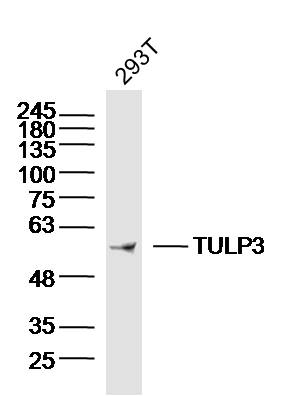TULP3 Rabbit pAb
TULP3 Rabbit pAb
- 产品详情
- 实验流程
- 背景知识
Application
| WB |
|---|---|
| Primary Accession | O75386 |
| Reactivity | Rat, Chicken, Dog |
| Host | Rabbit |
| Clonality | Polyclonal |
| Calculated MW | 49642 Da |
| Physical State | Liquid |
| Immunogen | KLH conjugated synthetic peptide derived from human TULP3 |
| Epitope Specificity | 251-350/442 |
| Isotype | IgG |
| Purity | affinity purified by Protein A |
| Buffer | 0.01M TBS (pH7.4) with 1% BSA, 0.02% Proclin300 and 50% Glycerol. |
| SUBCELLULAR LOCATION | Nucleus. Cell membrane. Cell projection, cilium (By similarity). Cytoplasm (By similarity). Secreted (By similarity). Note=Does not have a cleavable signal peptide and is secreted by a non-conventional pathway (By similarity). Translocates from the plasma membrane to the nucleus upon activation of guanine nucleotide-binding protein G(q) subunit alpha. |
| SIMILARITY | Belongs to the TUB family. |
| Important Note | This product as supplied is intended for research use only, not for use in human, therapeutic or diagnostic applications. |
| Background Descriptions | Mutations in the mouse Tub gene gradually lead to obesity, strongly resembling the late-onset obesity observed in the human population. In addition to excessive deposition of adipose tissue, mice with the Tub phenotype also suffer retinal degeneration and neurosensory hearing loss. A human homolog of the Tub gene has been identified, as have three related proteins, called Tubby-like protein 1 (TULP1), TULP2 and TULP3. When compared to TULP1 and TULP2, TULP3 has a wider tissue expression and is phylogenetically more similar to Tub than either TULP1 or TULP2. TULP1, expressed specifically in the retina, maps to the chromosomal region known to be involved in retinitis pigmentosa, while TULP2 maps within the minimal interval for the rod-cone dystrophy. TULP3 maps to human chromosome 12p13, and shares 69% homology to mouse TULP3. Human RNA from testis, ovary, thyroid and spinal cord contain highly detectable levels of TULP3 transcripts. In the retina, TULP3 is expressed specifically in the inner nuclear layer and ganglion cell layer. TULP1, TULP2 and TULP3 may comprise a unique family of bipartite transcription factors. |
| Gene ID | 7289 |
|---|---|
| Other Names | Tubby-related protein 3, Tubby-like protein 3, TULP3 (HGNC:12425), TUBL3 |
| Target/Specificity | Expressed at high levels in testis, ovaries, thyroid, and spinal chord. |
| Dilution | WB=1:500-2000 |
| Storage | Store at -20 °C for one year. Avoid repeated freeze/thaw cycles. When reconstituted in sterile pH 7.4 0.01M PBS or diluent of antibody the antibody is stable for at least two weeks at 2-4 °C. |
| Name | TULP3 (HGNC:12425) |
|---|---|
| Synonyms | TUBL3 |
| Function | Negative regulator of the Shh signaling transduction pathway: recruited to primary cilia via association with the IFT complex A (IFT- A) and is required for recruitment of G protein-coupled receptor GPR161 to cilia, a promoter of PKA-dependent basal repression machinery in Shh signaling. Binds to phosphorylated inositide (phosphoinositide) lipids. Both IFT-A- and phosphoinositide-binding properties are required to regulate ciliary G protein-coupled receptor trafficking. During adipogenesis, regulates ciliary trafficking of FFAR4 in preadipocytes. |
| Cellular Location | Nucleus. Cell membrane. Cell projection, cilium. Cytoplasm. Secreted. Note=Does not have a cleavable signal peptide and is secreted by a non-conventional pathway (By similarity). Translocates from the plasma membrane to the nucleus upon activation of guanine nucleotide-binding protein G(q) subunit alpha |
| Tissue Location | Expressed at high levels in testis, ovaries, thyroid, and spinal cord. |
For Research Use Only. Not For Use In Diagnostic Procedures.
Provided below are standard protocols that you may find useful for product applications.
BACKGROUND
Mutations in the mouse Tub gene gradually lead to obesity, strongly resembling the late-onset obesity observed in the human population. In addition to excessive deposition of adipose tissue, mice with the Tub phenotype also suffer retinal degeneration and neurosensory hearing loss. A human homolog of the Tub gene has been identified, as have three related proteins, called Tubby-like protein 1 (TULP1), TULP2 and TULP3. When compared to TULP1 and TULP2, TULP3 has a wider tissue expression and is phylogenetically more similar to Tub than either TULP1 or TULP2. TULP1, expressed specifically in the retina, maps to the chromosomal region known to be involved in retinitis pigmentosa, while TULP2 maps within the minimal interval for the rod-cone dystrophy. TULP3 maps to human chromosome 12p13, and shares 69% homology to mouse TULP3. Human RNA from testis, ovary, thyroid and spinal cord contain highly detectable levels of TULP3 transcripts. In the retina, TULP3 is expressed specifically in the inner nuclear layer and ganglion cell layer. TULP1, TULP2 and TULP3 may comprise a unique family of bipartite transcription factors.
终于等到您。ABCEPTA(百远生物)抗体产品。
点击下方“我要评价 ”按钮提交您的反馈信息,您的反馈和评价是我们最宝贵的财富之一,
我们将在1-3个工作日内处理您的反馈信息。
如有疑问,联系:0512-88856768 tech-china@abcepta.com.























 癌症的基本特征包括细胞增殖、血管生成、迁移、凋亡逃避机制和细胞永生等。找到癌症发生过程中这些通路的关键标记物和对应的抗体用于检测至关重要。
癌症的基本特征包括细胞增殖、血管生成、迁移、凋亡逃避机制和细胞永生等。找到癌症发生过程中这些通路的关键标记物和对应的抗体用于检测至关重要。 为您推荐一个泛素化位点预测神器——泛素化分析工具,可以为您的蛋白的泛素化位点作出预测和评分。
为您推荐一个泛素化位点预测神器——泛素化分析工具,可以为您的蛋白的泛素化位点作出预测和评分。 细胞自噬受体图形绘图工具为你的蛋白的细胞受体结合位点作出预测和评分,识别结合到自噬通路中的蛋白是非常重要的,便于让我们理解自噬在正常生理、病理过程中的作用,如发育、细胞分化、神经退化性疾病、压力条件下、感染和癌症。
细胞自噬受体图形绘图工具为你的蛋白的细胞受体结合位点作出预测和评分,识别结合到自噬通路中的蛋白是非常重要的,便于让我们理解自噬在正常生理、病理过程中的作用,如发育、细胞分化、神经退化性疾病、压力条件下、感染和癌症。






